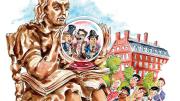The debate over Hispanic assimilation in America has tended to sidestep a troubling reality. In many of the places where immigrants are making the deepest inroads, native minorities—and low-income blacks, in particular—are losing ground. This equation has complicated any clear liberal/conservative divide on the immigration question.
George Borjas, Scrivner professor of economics and public policy at the Kennedy School of Government, has argued forcefully for restricting the flow of poor labor migrants into the United States. Using census data from 1960 to 2000, Borjas links increased immigration, especially from Mexico, and declining wages at the bottom rungs of the U.S. economy, where native-born minorities are heavily concentrated. A 10 percent increase in the size of a given skill group, his data show, reduces annual earnings of salaried workers in that skill group by 7.1 percent. Borjas maintains that low-income African Americans—particularly those without high-school degrees—have been hardest hit by the influx of Mexican workers into the labor force. As the earning prospects of unskilled blacks have gone down, crime has gone up. Borjas graphed a correlation between a rise in immigration in the 1970s and an increased incarceration rate for African-American males.
Critics have challenged Borjas’s economic findings, and some have even accused him of ethnic prejudice for deeming Mexicans “less worthy” than other immigrant groups. (Borjas himself is a first-generation Cuban immigrant.) But Borjas is not alone in the view that immigration has adversely affected the most economically vulnerable African Americans. Sociologist William Julius Wilson—Geyser University Professor at the Kennedy School—asserts that Hispanic immigrants have undercut inner-city blacks in the low-wage labor market in Chicago. In a 1988 survey of Chicago employers, conducted for his 1996 book When Work Disappears, Wilson found that employers overwhelmingly preferred to hire immigrants for entry-level positions over blacks—and especially over black males. Racial stereotypes exert a powerful economic influence in the low-wage service sector. “Because black males are perceived as dangerous, belligerent, unreliable, and somewhat lazy,” he says, “employers do not want them interacting with consumers.” As long as there is a ready supply of immigrant labor, employers will choose immigrants first. Wilson notes that blacks fared somewhat better during the economic boom of the late 1990s, when labor markets were tight; but the slack labor markets since have favored employer preferences.
Social and economic tensions between blacks and Hispanics have been growing in recent years, particularly in many of the “new immigrant destinations.” In Georgia, the jobless rate for black men is nearly triple that of Hispanic men, according to labor statistics cited by the New York Times of October 3, 2006. In Atkinson County, Georgia, more blacks than Hispanics fail to meet minimum standards in the public schools. “If you have 10 factory openings, I would say Hispanics would get the majority of the jobs now,” Joyce Taylor, the Atkinson County clerk, who is black, told the Times. “And if you look at the little grocery stores, there are more Hispanic businesses than black businesses.” Interracial contact in these locales does not seem to reduce frictions. A 2006 study published in the Journal of Politics found that neighborhood contact between blacks and Hispanics in Durham, North Carolina, intensified group stereotypes and increased the likelihood that Hispanics would identify themselves more with whites than with blacks.
Helen Marrow, a Ph.D. candidate in sociology and social policy, has been investigating the dynamics of black-Hispanic race relations in the rural and small-town South. In places where blacks form the majority, she finds, their economic resentment of newcomers tends to be greater than in places where blacks are in the minority. “Strength in numbers” applies in the political context but not in the socioeconomic arena; a high proportion of African Americans in a county, she concludes, exacerbates black-Hispanic tensions by elevating African Americans’ sense of individual and group-level threat. Marrow says her research findings suggest “a fairly bleak scenario” for black-Hispanic socioeconomic conflict in such locales.
This disturbing trend has no easy solution. According to Wilson, black leaders are ambivalent about how to address the perceived threat from Hispanic immigration. On the one hand, they identify with immigrants—many of whom are poor people of color—and they are opposed to discrimination; but, at the same time, they perceive the negative impact that immigrants are having on low-wage blacks. Wilson himself says that, although he doesn’t agree with the “conservative restrictionist position,” he would like to see “a humane immigration policy that is more likely to help workers in this country than hurt them.”






